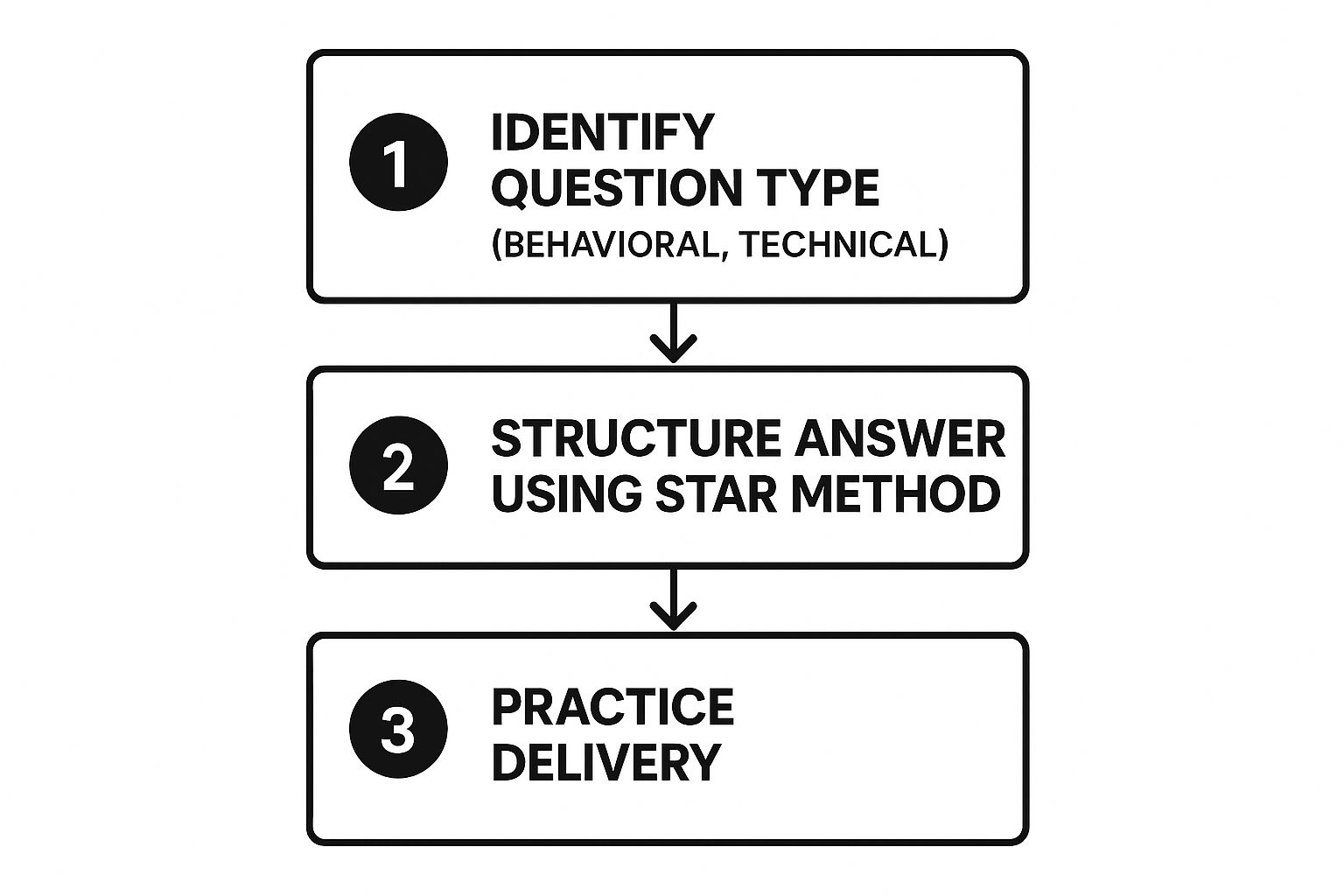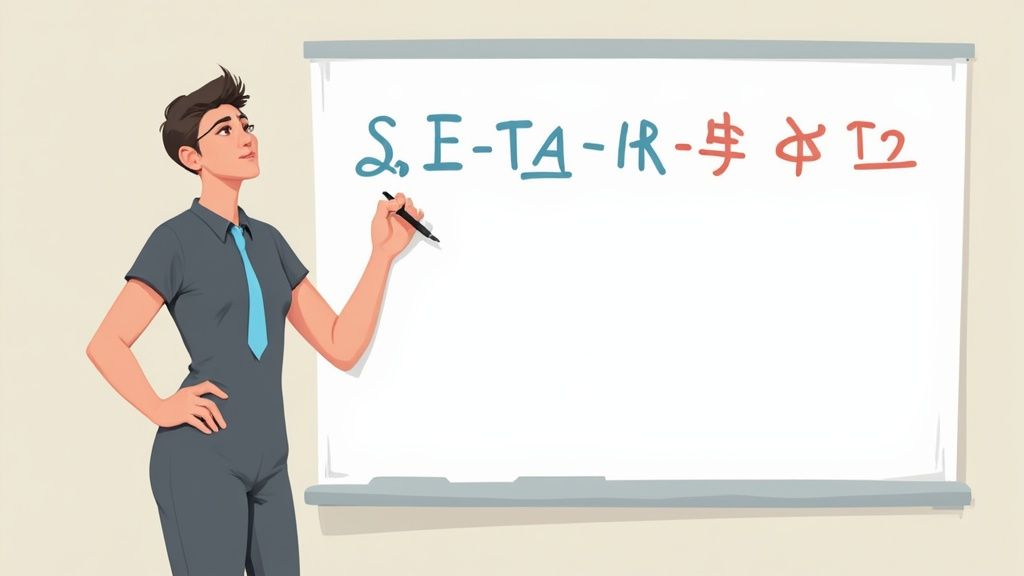
Master Answering Tough Interview Questions with Confidence
Published
Answering tough interview questions isn't about having a perfect, memorized script. It's about having a solid framework to handle whatever comes your way. I've found that the real skill lies in understanding the question behind the question, telling a compelling story, and tying your experience directly to what the company needs.
Why Mastering Tough Questions Gives You a Serious Edge

Let's be real—the job market is incredibly competitive. Your resume and cover letter are just the entry ticket. The interview, especially those challenging questions, is where hiring managers find out who you really are. They're not just trying to make you squirm; they’re creating a moment of pressure to see how you think on your feet.
These questions are designed to get past your rehearsed answers and uncover what really matters:
- Problem-Solving Skills: What's your process when you don't know the answer right away?
- Cultural Fit: Do your values and work style actually mesh with the team?
- Grace Under Pressure: Can you stay cool and articulate when the heat is on?
- Self-Awareness: Do you have a realistic grasp of your strengths and weaknesses?
To get a clearer picture of what hiring managers are looking for, it helps to decode their questions.
What Interviewers Really Mean by These Questions
This table breaks down some of the most common types of tough questions, revealing the skills and qualities employers are actually trying to assess.
| Question Type | Example Question | What the Interviewer Really Wants to Know |
|---|---|---|
| Behavioral | "Tell me about a time you failed." | How do you handle setbacks? Do you learn from your mistakes? Can you show humility and resilience? |
| Situational | "What would you do if a key client was unhappy with your work?" | How do you approach conflict and problem-solving? Can you think strategically under pressure? |
| Competency-Based | "Describe a complex project you managed from start to finish." | Can you demonstrate specific skills like leadership, project management, or organization with real-world proof? |
| Curveball | "If you were an animal, what would you be?" | Are you creative? Can you think on your feet? How does your personality align with the role and company culture? |
Knowing the "why" behind the question is half the battle. It allows you to shape your answer to highlight the exact qualities they're searching for.
Turning Pressure into Your Big Moment
Instead of dreading these questions, see them for what they are: a golden opportunity. A tough question is your chance to stand out from all the other qualified people in the running. Anyone can list skills on a resume, but very few can tell a memorable story that proves they've used those skills effectively. This is where you go from being "another applicant" to "the candidate they remember."
The numbers don't lie. A single corporate job opening attracts an average of 118 applicants, but only 20% of them will get an interview. That means you're up against roughly 23 other candidates. Your answers in that room are what make all the difference.
Your goal isn't just to get through tough questions—it's to use them to shine. One great answer to a difficult question will leave a more powerful, positive impression than ten easy answers combined.
From Practice to Peak Performance
Getting good at this takes practice. It’s like building muscle; you have to train yourself to quickly break down a question, figure out what they're really asking, and pull a relevant story from your experience. This is especially critical in roles where you might face very specific questions, like those interviewing for remote positions who need to be ready for unique https://influencermarketingjobs.net/blog/remote-job-interview-questions about self-discipline and communication.
The more you practice, the more natural and confident you'll sound. To really get an edge, you need to make it a habit. For some great strategies on how to do this effectively, check out these 7 Proven Job Interview Practice Methods. When you shift your mindset from fear to preparation, you turn a potential stumbling block into a launchpad, proving you have the substance to back up what's on your resume.
A Simple Framework for Any Hard Question
Let’s be honest, trying to memorize canned answers for every possible interview question is a losing battle. A much better approach? Develop a reliable system you can apply on the fly, no matter what a hiring manager throws at you.
Having a go-to framework isn't about scripting a perfect response. It's about knowing how to break down the real question, build a compelling answer, and tie it all back to what the company actually needs. It’s a strategy that keeps you in control.
Deconstruct the Real Question
First things first: when a tough question comes your way, your initial instinct might be to jump in and start talking. Don't. Take a moment to breathe.
It's completely fine—in fact, it's impressive—to say, "That's a great question. Let me think about that for a second." This small pause accomplishes two huge things. It shows you're thoughtful, not just reactive, and it gives you a critical moment to figure out what they're really asking.
Is it a behavioral question digging into your past experience? A situational question testing your judgment? Or a technical question to gauge your skills? Pinpointing the type of question helps you pull the right story from your mental files.
A Twin Employment study found that 47% of interviewers would reject a candidate simply for having poor knowledge of the company. This really drives home how important it is to connect your answers directly to their world and their needs.
Structure Your Answer for Impact
Once you know what they’re after, you need a structure. This is what separates a sharp, memorable answer from a rambling one. Think of it as telling a mini-story that’s easy for the interviewer to follow.
I've found a simple, three-part flow works wonders:
- Acknowledge and Reframe: Start by briefly repeating the question in your own words. This confirms you understood it correctly.
- Provide Your Example: This is the core of your answer. Share a concise, relevant story or lay out a logical plan.
- Connect to the Role: This is the money-maker. Explicitly link your example back to the job description or the company's goals. Show them why your experience matters to them.
This visual gives you a great overview of how this process flows from start to finish.

As you can see, it’s a strategic cycle: understand, structure, and refine. It’s a method for turning a tough spot into a chance to shine.
Adapt the Framework in Real-Time
The beauty of this framework is its flexibility. It works just as well in a traditional office as it does over a video call. Being able to adapt is a skill in itself, and you can get more specific advice on handling remote interviews with our guide on online interview tips.
Let's walk through how this plays out in a couple of common scenarios.
Scenario 1: The Behavioral Question
- Question: "Tell me about a time you had to deal with a difficult team member."
- Framework in Action: You immediately recognize this as a behavioral question. You pause, recall a specific time you handled a conflict professionally, and tell that story. You wrap it up by explaining how your communication style fosters the kind of collaborative team environment they’ve mentioned is important to them.
Scenario 2: The Situational Question
- Question: "What would you do if a major project you were leading fell behind schedule?"
- Framework in Action: This is a situational question testing your problem-solving process. You’d outline your plan: first, assess the situation to find the root cause; second, communicate the delay and its impact to stakeholders; third, create a revised timeline to get back on track. You then connect this logical approach directly to the project management duties in the job description.
Using this framework moves you beyond simply answering questions. You're demonstrating your thought process, your professionalism, and how you’ll add real value. It turns a moment of pressure into your opportunity to prove you're the right person for the job.
Telling Your Best Story with the STAR Method

When an interviewer leans in and says, "Tell me about a time when...," they're giving you a golden opportunity. This isn't small talk. It's an invitation to prove your skills with a real-world story, and the STAR method is your secret weapon for telling it well.
Think of it as a simple, powerful formula for structuring your answer: Situation, Task, Action, and Result.
Using this framework is the difference between a rambling, forgettable response and a sharp, compelling narrative that sticks with the hiring manager. It keeps you focused and ensures you deliver the exact information they’re looking for.
Let's walk through how to use each part to make your story shine.
Situation: Set the Scene Quickly
First, you need to paint a picture. The Situation is your story’s opening, and the key is to provide just enough context for your story to make sense. No more, no less.
Think of it like setting up the first scene in a movie. You need to quickly establish the who, what, and where. For instance: "In my last role as a Social Media Manager, our organic engagement had been totally flat for two quarters straight."
That one sentence does a lot of work. It establishes your role, the company context, and the core problem. It’s concise and immediately gets to the heart of the matter.
Task: Define Your Specific Mission
Next up is the Task. This is where you zoom in on your specific responsibility. What was the exact goal you were given or the problem you were meant to solve? This is crucial for showing your direct involvement.
Let’s continue the example. Your task might sound like this: "My director challenged me to develop a new content strategy from scratch and increase our audience interaction by 15% within three months."
See how specific that is? It’s not a fuzzy goal like "improve engagement." It’s a measurable objective with a clear timeline. This precision shows the interviewer you’re someone who understands and works toward tangible business goals.
A well-defined task demonstrates that you can grasp the strategic importance of your work. It shows you don't just complete assignments—you understand the "why" behind them, connecting your duties to the bigger picture.
Action: Showcase Your Unique Contribution
Now for the main event: the Action. This is the heart of your story, where you walk the interviewer through the specific steps you took to get the job done. The most important word here is "I." It’s so easy to fall into the "we did this" or "the team decided" trap, but the interviewer needs to understand your individual contribution.
This is your moment to be detailed and use strong, active language.
- A weak example: "We brainstormed some new ideas for posts." This is passive and doesn't tell them anything about what you actually did.
- A much better example: "I started by running a full competitor analysis to find content gaps. Using that data, I personally designed a new content calendar that prioritized interactive polls and user-generated content. I then scripted, shot, and launched a three-part video series showcasing our top customer success stories."
The second version is packed with power. It highlights your analytical skills, strategic thinking, and the concrete actions you took to move the needle.
Result: Quantify Your Impact
Finally, you bring it home with the Result. This is where you share the outcome of all your hard work. The best way to do this is with numbers. Hard data makes your achievements feel real and impressive, far more than a vague statement ever could.
Let's close out our story: "The new strategy was a huge success. We actually beat our goal, increasing organic engagement by 22% in just two months. That video series I created pulled in over 50,000 views and even got featured in an industry publication, which led directly to a 10% jump in inbound demo requests."
This result is powerful because it connects your actions to real business outcomes—more engagement, better brand visibility, and even new sales leads.
Before and After: The STAR Method in Action
Let's look at a side-by-side comparison for the classic question, "Tell me about a time you handled a tight deadline."
Weak Answer (Without STAR): "Yeah, there was this one time a big project got moved up unexpectedly. It was pretty stressful, but we all just worked really hard and got it done. The client was happy, so it worked out."
This answer is forgettable. It has no detail, no sense of ownership, and no measurable impact.
Strong Answer (With STAR):
- (Situation): "In my project coordinator role, we were two weeks away from launching a major marketing campaign for a key client. Suddenly, they asked us to move the deadline up a full week to capitalize on an unexpected industry event."
- (Task): "My job was to completely re-scope the project, reallocate our team's resources, and guarantee every deliverable was completed on the new, aggressive timeline without letting the quality slip."
- (Action): "I immediately rebuilt the project timeline in Asana, flagging the absolute critical path tasks. I then set up daily 15-minute stand-up meetings with the design and content leads to keep us all in sync and clear any roadblocks. To speed things up, I personally took over the final QA checks, which freed up our specialists to focus on their core tasks."
- (Result): "We successfully delivered the entire campaign by the new deadline. The client was so impressed by our speed and execution that they immediately signed a six-month retainer for additional work, worth over $50,000 to our agency."
By mastering the STAR method, you’re doing more than just answering a question. You're telling a memorable story that proves your value and makes you the candidate they can't forget.
How to Nail Those "What Would You Do If..." Questions
While the STAR method is your best friend for answering questions about your past, interviewers also want to see how you think about the future. That’s where hypothetical "what would you do if..." scenarios come in. They aren't trying to see if you have a crystal ball; they're testing your judgment, your problem-solving process, and how you perform under pressure.
These questions are a different beast than behavioral ones. There’s no past story to pull from. Instead, you have to create a logical, forward-thinking plan right on the spot. It’s a fantastic opportunity to show exactly how you'd tackle challenges specific to their company and the role you're after.
Start With a Little Reconnaissance
Don't just jump straight into a solution. The most impressive candidates I've interviewed always start by asking smart, clarifying questions. Interviewers often make these scenarios intentionally vague to see if you'll make assumptions or dig for more information.
Let's say they ask: "What would you do if a major marketing campaign you launched was underperforming a week after launch?"
Instead of rattling off a list of fixes, pause and probe a little. You could ask:
- "To give you the best answer, could you tell me what the key performance indicators (KPIs) are? Are we talking about low clicks, poor conversions, or maybe just not enough social media buzz?"
- "What channels is the campaign running on? Is this mainly on social, or are we also using email and paid search?"
- "What's our budget looking like for this campaign? Is there any wiggle room to make adjustments?"
Asking these questions immediately signals that you're analytical and don't rush into action. You gather data first—a skill every hiring manager loves. This approach turns a simple Q&A into a more collaborative, problem-solving conversation.
Lay Out Your Action Plan
Once you have a clearer picture, it's time to walk the interviewer through your plan. The key here is to think out loud, showing them how you structure your thoughts and build a coherent strategy. This isn't about having the perfect answer, but about demonstrating a sound process.
Sticking with our underperforming campaign example, your plan might sound something like this:
- Immediate Triage: "Okay, the first thing I'd do is a deep dive into the analytics to pinpoint exactly where things are breaking down. Is our ad click-through rate the problem, or are people bouncing off the landing page?"
- Hypothesize and Test: "Based on that data, I’d come up with a few educated guesses. Maybe the ad copy isn't hitting home with our audience, or the landing page is confusing. I’d then suggest a few small, quick A/B tests—like tweaking a headline or changing the call-to-action button—to see if we can validate one of those hypotheses."
- Communicate and Collaborate: "At the same time, I’d be proactive about updating key stakeholders on my findings and proposed actions. I’d also pull in the creative team to get their take on it. Keeping everyone in the loop is critical."
This kind of structured response shows you can handle a mini-crisis calmly and methodically, which is far more impressive than just throwing out random ideas.
A common mistake I see candidates make is giving a single, definitive answer. The best responses explore a few angles and show you're a flexible, adaptable thinker. The process you describe is often way more important than the specific solution you land on.
Always Explain the "Why"
Simply listing your steps isn't enough to stand out. The real magic happens when you explain the reasoning behind each action. This connects your plan to a bigger strategic purpose and proves your decisions are intentional.
As you explain your plan, tie your actions to a purpose. For example: "I would start with the analytics because making data-driven decisions is the only way to avoid wasting more budget on what isn't working." Or, "I would communicate with stakeholders early because transparency is crucial for managing expectations and maintaining trust, especially when things aren't going perfectly."
Explaining your "why" elevates your answer from a simple to-do list to a masterclass in strategic thinking. It gives the interviewer a peek into your professional values, whether that’s a focus on data, collaboration, or stakeholder management. This is how you prove you have the judgment they’re looking for.
Look Ahead to Potential Outcomes
Finally, a truly top-tier answer doesn't just stop at the immediate plan. It looks ahead to consider potential outcomes and the next steps. This shows you're a forward-thinker who understands that every action has a ripple effect.
Wrap it up by briefly touching on what you'd expect to see. "By running these quick A/B tests, we should be able to spot the core issue within 48-72 hours. If our hunch is correct, we should see a noticeable lift in our main KPI—say, a 15-20% increase in click-through rates—by the end of the week."
You can even add a contingency plan. "And if those initial tests don't move the needle, my next move would be to re-evaluate our audience targeting to make sure we're even talking to the right people." This final layer shows real foresight and a pragmatic understanding that not every plan works the first time. It proves you're ready to adapt and keep pushing for a better result.
Answering Technical Questions When You're Unsure

So you're in an interview for a role in tech, engineering, or data science. A tough technical question lands on the table, and you can feel that spotlight switch on. Your mind starts racing for the perfect, textbook answer.
But what happens when you draw a blank?
First, take a breath. In these moments, the interviewer is usually testing something far more important than your ability to recall facts: they want to see how you think. Your knack for breaking down a complex problem and talking through your process is often way more valuable than spitting out a single "correct" answer.
Shift Your Goal from Answering to Problem-Solving
The biggest mistake I see candidates make is freezing up because they don’t immediately know the solution. Instead of letting panic set in, you need to reframe your objective. Your new goal isn't to answer the question perfectly but to show the interviewer how you'd go about solving it.
This simple shift in mindset takes a ton of pressure off. It transforms a high-stakes test into something more like a collaborative brainstorming session, giving you a platform to show off your real analytical skills.
Answering tough technical questions is less about having the right answer and more about showing the right approach. Your thought process reveals your true capabilities far more than a single piece of trivia.
Think of yourself as a detective. You might not know who the culprit is right away, but you can absolutely show the lead inspector how you’d gather clues, analyze the evidence, and follow a logical path to crack the case. That’s precisely what the hiring manager is looking for.
Think Out Loud and Deconstruct the Problem
Start by verbalizing your initial thoughts. This is so important—it shows you’re engaged and actively working on the problem, not just sitting there silently stumped.
The best way to start is by breaking the big, intimidating question into smaller, more digestible pieces. This technique, often called decomposition, is a fundamental skill in engineering and problem-solving. It proves you can create structure out of chaos.
Let's walk through a common scenario:
- The Question: "How would you design a system to handle a million daily image uploads for a social media app?"
- Your Out-Loud Process: "Okay, that's a big challenge. My first instinct is to break this down. We have to consider the upload process itself, how we're going to store all those images, and then how we serve them back to users quickly. I think I'd start by tackling the user-facing part—the upload API."
Just like that, you've shown the interviewer you have a structured method and aren't overwhelmed by the scale of the question.
State Your Assumptions and Ask Clarifying Questions
No complex problem ever exists in a vacuum. I can tell a senior candidate from a junior one by whether they ask clarifying questions. Stating your assumptions and probing for more context is a hallmark of an experienced professional.
Continuing with our image upload example, you could follow up with questions like:
- "Am I right to assume these images will vary in size, or are we working with a standard resolution?"
- "What are the performance goals here? For example, how quickly does an image need to be available to other users after it's uploaded?"
- "Are we trying to optimize for cost, speed, or reliability? Or do we need to strike a balance between all three?"
These questions show you understand the trade-offs that come with any real-world system design. You’re proving you think like a member of the team, not just a candidate in an interview chair.
Connect Theory to Practical Application
Even if you don't know the exact technology or a specific algorithm, you can always fall back on your foundational knowledge. This is especially true in fields like data science, where interviewers care more about your analytical mind than your ability to memorize libraries.
In these interviews, they want to see how you apply core concepts to solve actual business problems. You can explore how top companies use statistics questions to evaluate problem-solving skills to get a better feel for this. A candidate who can talk through how they’d use hypothesis testing or error analysis to tackle a real scenario is infinitely more valuable than someone who can only define the terms.
Even if you can’t name the perfect tool for the job, you can describe the type of tool you’d look for. You could say something like, "I haven't personally used that specific library, but in a situation like this, I'd look for a solution that handles asynchronous processing so the user isn't stuck waiting. I'd probably start by researching message queue systems like..."
This approach cleverly turns a potential weakness—not knowing a specific tool—into a major strength. It showcases your resourcefulness and your solid grasp of the underlying principles. By showing them how you solve problems, you give them the confidence they need to hire you.
Frequently Asked Questions About Tough Interviews
Even after you've prepped with frameworks and rehearsed your stories, some interview moments can still catch you off guard. Let's walk through a few of the most common and tricky situations that candidates run into. Think of this as your quick-reference guide for those "what do I do now?" panics.
The advice here is straightforward and designed to give you a clear path forward when you feel stuck.
What Should I Do If My Mind Goes Completely Blank?
We’ve all been there. It’s a terrifying feeling, but the key is not to let the panic take over. The interviewer is human; they don't expect a perfect, pre-programmed robot.
Your first move is to just breathe. Buy yourself a second to reset.
It's completely fine to say something like, “That’s a great question. Let me take a moment to think of the most relevant example.” This simple phrase projects composure and shows you’re being thoughtful, not just blurting out the first thing that comes to mind.
Another savvy move is to ask a clarifying question. For instance, if they ask about a project failure, you could respond with, “To make sure I give you the best answer, are you more interested in the team dynamics of that situation or the technical lessons I learned from it?” This does two things: it gives your brain a chance to catch up, and it helps you tailor your answer to exactly what they're looking for.
How Do I Answer The Dreaded Weakness Question?
"What's your biggest weakness?" is a classic because it’s a direct test of self-awareness and honesty. Whatever you do, avoid the clichés. Answers like “I’m a perfectionist” or “I work too hard” sound fake, and hiring managers have heard them a million times.
A much stronger approach has three parts.
- Acknowledge a real, but minor, weakness. Make sure it isn't a non-negotiable skill for the job. If you’re not in a constant public-facing role, you might mention a past discomfort with public speaking.
- Show how you're actively addressing it. This is the most critical step. "I knew this was an area for growth, so I joined a local Toastmasters club. I also now volunteer to lead our weekly team stand-ups to get more practice."
- Share the positive result. "It's honestly made me a much more confident communicator, which has been incredibly helpful in leading project meetings and presenting ideas to stakeholders."
This formula transforms a potential negative into a compelling story about growth and initiative—which is exactly what interviewers want to see.
Is It Really Okay to Say “I Don’t Know”?
Just saying "I don't know" and leaving it at that is a huge missed opportunity. Yes, be honest, but you can frame your response to showcase your problem-solving skills instead of just admitting a knowledge gap.
A far more powerful way to handle this is to be upfront and then immediately pivot to your thought process.
"That's a specific scenario I haven't personally encountered yet. However, drawing from my experience with a similar challenge involving [mention a related project], my approach would be to first..."
From there, you can walk them through the logical steps you'd take to find the answer. Mention who you would consult, what data you would pull, and how you would analyze the situation to find a solution. You turn a moment of not knowing into a live demonstration of your critical thinking and resourcefulness. Often, that's far more valuable than already knowing a single fact.
How Should I Handle Those Bizarre Oddball Questions?
Questions like “If you were an animal, what would you be?” or “If you were a brand, what’s your slogan?” can feel ridiculous, but they have a purpose. They’re designed to see how you think on your feet, test your creativity, and get a glimpse of your personality.
Don't get bogged down trying to find the single "right" answer—there isn't one. The goal is to quickly link the traits of whatever you choose to positive, professional qualities that matter for the role.
Example Scenario:
- Question: "What kind of animal would you be and why?"
- A Strong Answer: "I’d probably be a duck. On the surface, they look calm and serene, but underneath, they're paddling furiously to move forward. I relate to that because I pride myself on staying composed and focused under pressure, even when I’m working hard behind the scenes to drive results."
This kind of response is memorable, clever, and subtly reinforces that you’re hardworking, composed, and results-oriented.
While this guide covers a range of general interview challenges, those in specialized fields should also prepare for role-specific inquiries. For instance, you can find more targeted advice by exploring a list of marketing interview questions and answers to get ready for more technical discussions.
At Influencer Marketing Jobs, we know that landing your dream role is about more than just a great resume—it's about acing the interview. Our job board is your go-to resource for finding opportunities that match your skills and career goals in the exciting world of digital and influencer marketing.